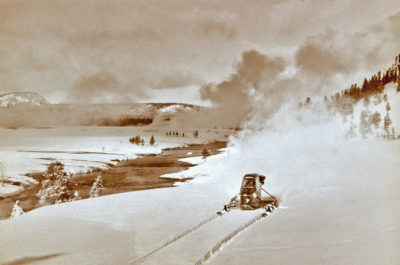The Town Grows and Changes
The pioneer roads leading to the future West Yellowstone came from parts of eastern Idaho and southwestern Montana. In 1914, the Gallatin Road, connecting the settlement to Bozeman and known today as U.S. 191, was completed. Still, the roads were dirt and poorly maintained. Deep ruts that formed in the spring muddy season hardened into hazardous terrain for horses’ hooves and vehicles’ narrow tires during the summer. In spite of the rough roads, the area was becoming ever more popular as a park way station. The West Gate achieved its longstanding distinction as the busiest park entrance of all in 1913. In 1915, the Panama Pacific Exposition in San Francisco, which highlighted the Wonders of Yellowstone, along with a new regulation which allowed automobiles to tour the park, fueled the town’s prosperity.
Meanwhile, snow continued to prevent convenient winter travel to and from West Yellowstone. Winter mail service came in via dog sleds from Henry’s Lake, Idaho, but residents were confined to the basin unless they were willing to ski or drive dog sleds out.
Natural disasters have threatened West Yellowstone throughout its history. Most significant were the 1959 Earthquake and the Fires of 1988. The earthquake rattled many buildings in the community, causing significant damage to the rock chimneys of the railroad buildings. Fortunately, the fires in 1988 stopped short of the town boundary.
The mid-1930s delivered pivotal changes for West Yellowstone. In 1935, an airport was built on Forest Service Land just to the west of town. (The airport was moved to its present location further north and expanded to accommodate larger planes in 1965.) In 1936, the highways north and south of town were paved. Plows cleared the roads of winter snow, opening the community for year-round access.
Other industries that relied upon the area’s resources joined tourism. Lumber mills and tie-hacking (the making of railroad ties) took advantage of the plentiful timber stands and the proximity to transportation provided by the trains. However, by the early 1970s, these industries had vanished. Providing lodging, meals, gas, and memorabilia proved to be the mainstay for the life of the community. The West Yellowstone area attracted other forms of outdoor recreation in addition to park sightseeing. All through the 1900s, West Yellowstone grew in stature as a mecca for hunting and fly fishing. Many shops catering exclusively to pursuers of these outdoor activities sprang up in town. The Madison River spawned the career of many a famous fly fisher – both locally and nationally. In the 1950s, over-the-snow vehicles made their appearance in town.
Home-built snow planes and commercial Bombardier snow coaches ushered in a new mode of winter travel. Snowmobiles became popular in the early 1960s, and winter tourism was off and running. Meanwhile, cross-country skiing on the forest and park trails just outside of town attracted Nordic enthusiasts from far and wide. The Rendezvous Ski Trails, with their gateway right in West Yellowstone, provide a popular venue for ski races. The park officially opened for winter use in 1971 with a full range of visitor services, including overnight lodging. This further boosted winter tourism traffic. Sadly, while new recreational opportunities grew, a long tradition was coming to an end. Train ridership plummeted after World War II, as auto travel increased and then commercial air travel rose in popularity. The Union Pacific halted passenger service aboard the Yellowstone Special in 1960. Although rumors of the railroad buildings’ demise surfaced, their future was secured when the town accepted ownership of them in 1969.




